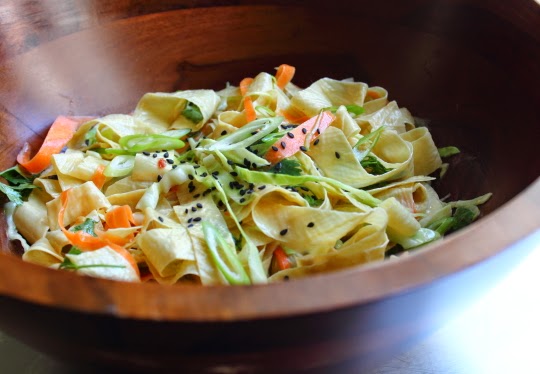Happy Chinese New Year! It’s the Year of the Dog (and not the Manatee), and to celebrate I thought I’d show you my take on Chinese scallion pancakes . These fun-to-make flatbreads
. These fun-to-make flatbreads are a common fixture on menus around here, and while they all feature the same few ingredients, they come in a variety of thicknesses, which really affects the texture.
are a common fixture on menus around here, and while they all feature the same few ingredients, they come in a variety of thicknesses, which really affects the texture.
The thinner you make these, the crispier they’ll be, but you won’t get that nice, layered, oniony inside. On the other hand, if you make them too thick, they can be a little doughy inside, so I try to shoot for something in between. Speaking of inside, feel free to add pepper flakes or other appropriate embellishments before you roll these up.
Ideally, you leave the dough overnight before using, but I’ve always had great results with just a couple hours rest on the counter. If you do leave overnight, you’ll probably get a better flavor, and maybe texture, but the dough will be more elastic, and slightly more difficult to work with.
As far as the dipping sauce goes, I like to mix equal parts seasoned rice vinegar , and soy sauce
, and soy sauce , flavored with a shot of hot sauce, and maybe grating of fresh ginger. Toss in a few sliced green onions, and you’ll have yourself a very basic, but perfect condiment for these savory pancakes. Regardless of how you serve them, I really hope you give these a try soon. Enjoy, and gung hay fat choy!
, flavored with a shot of hot sauce, and maybe grating of fresh ginger. Toss in a few sliced green onions, and you’ll have yourself a very basic, but perfect condiment for these savory pancakes. Regardless of how you serve them, I really hope you give these a try soon. Enjoy, and gung hay fat choy!
Ingredients for 2 Chinese Scallion Pancakes:
one bunch green onions, mostly green parts, sliced thinly
For the dough:
2 cups bread or all-purpose flour
1 1/2 teaspoon kosher salt
3/4 cup hot water
- adjust with more flour or water to form a smooth, but sticky dough
For the oil mixture:
3 tablespoon veg oil
2 teaspoons sesame oil
1 tablespoon plus 1 teaspoon flour
- serve with dipping sauce, as described in the blog post































